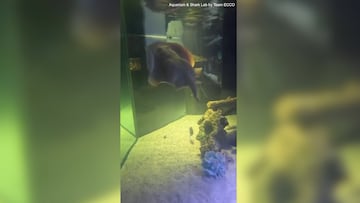Disappointing video of Charlotte the pregnant virgin stingray
Still no baby Jesus stingray to speak of as the Aquarium & Shark Lab in North Carolina show video of virgin Charlotte swimming around with her big belly.

A stingray Hendersonville, North Carolina became famous when she got pregnant through parthenogenesis - the scientific name for a virgin birth. The Aquarium & Shark Lab that’s housing Charlotte the pregnant virgin stingray (there’s a sentence I didn’t expect to write today) said back in February that she was due to have her four pups “any day now”. So you can imagine the disappointment of her fans when the only videos they’ve released since then are of Charlotte boringly swimming around with her swollen pregnant belly and no little miracle babies to speak of.
The important thing of course is that Charlotte is fully healthy and well. “She continues to be healthy and has a great appetite!” the aquarium wrote in an Instagram post. “She also initiates interactions with the divers and guests as seen in this video with diver Jacob!”
When will Charlotte the stingray give birth?
The typical gestation period for a stingray is three to four months, or possibly longer depending on the temperature of the water. Charlotte’s pregnancy is unique though, as it’s the first parthenogenesis ever recorded in her species. Professor of marine biology and director of the Shark Lab at California State University Dr. Christopher Lowe said that parthenogenesis can occur when a stingray is in isolation for too long as a desperate attempt to allow the species to continue on, effectively “cloning itself”.
“Cloning is essentially a ‘last ditch effort’ for species survival in situations where mates aren’t available,” said Lowe. Though the pregnancy type could indicate a low chance of survival for the embryos, the aquarium said that the pregnancy is so far going well.
Kevin Feldheim, a researcher at Chicago’s Field Museum, gave another possible explanation for Charlotte’s late birth. “Rays are capable of something known as embryonic diapause, where the embryos cease development until conditions are more suitable. This can stretch out gestation to periods longer than normal,” he said.
What other species can experience parthenogenesis?
This is the first known parthenogenesis in stingrays, but there are other species which experience the “virgin pregnancy”, reproducing without the need to fertilize the egg. Parthenogenesis occurs naturally in certain plants as well as algae, and some animal species - nematodes, some tardigrades, water fleas, some scorpions, aphids, some mites, some bees, some Phasmatodea, and parasitic wasps; and some vertebrates - certain fish, amphibians, reptiles, and even some birds.


Complete your personal details to comment